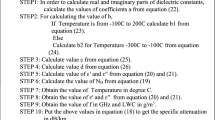Abstract
In this paper, I present the results of the measurements of rain-induced attenuation in the vertically polarized signal propagating at 12.25GHz during certain rain events, which occurred in the rainy wet season of the year 2001 at Yong-in, Korea (ITU-R rain zone K). The total experimentally measured attenuation over the link path was measured experimentally has been compared with that obtained using the International Telecommunication Union Radio Communication Sector (ITU-R) model. I also propose a prediction model which can predict the rain attenuation in satellite-earth communication links more conveniently and efficiently, by using the 1-h rain rate without conversion.
Preview
Unable to display preview. Download preview PDF.
Similar content being viewed by others
References
Ramadorai, T.C.: Rain attenuation and prediction in the Satellite-Earth Path. In: Proc. Workshop HF VHF and Microwave Communications, New Delhi, India (February 1987)
Crane, R.K.: Electromagnetic wave propagation through rain, pp. 1–4. John Wiley & Sons, Inc., Chichester (1996)
ITU-R: Propagation data and prediction methods required for the design of Earth-space Telecommunications systems. Rec. P.618, ITU-R (1997)
ITU-R: Specific attenuation model for rain for use in prediction methods. Rec. P.838, ITU-R (1999)
Choi, D.Y.: Measurement of Rain Attenuation of Microwaves at 12.25GHz in Korea. In: Boutaba, R., Almeroth, K.C., Puigjaner, R., Shen, S., Black, J.P. (eds.) NETWORKING 2005. LNCS, vol. 3462, pp. 1353–1356. Springer, Heidelberg (2005)
CCIR: Propagation data and prediction methods required for terrestrial line of sight systems. Rep. 564-3; Rep. and Recommendations of CCIR. Int. Telecommunication Union (1974-1986)
CCIR: Propagation data and prediction methods required for earth-space telecommunication systems. In: Proc. Plenary Assembly, Geneva, Switzerland, Rep. 564-4, vol. 5, pp. 447–505 (1990)
Olsen, R.L., Rogers, D.V., Hodge, D.B.: The aRb relation in the calculation of rain attenuation. IEEE Trans. Antennas propagation AP-26, 318–329 (1978)
Moupfouma, F., Martin, L.: Model of Rainfall Rate Distribution for Radio System Design. Proc. IEEE, vol. 132, Pt. H (1), 39–43 (1985)
Recommendation ITU-R P.311-11 (2003)
Dissanayake, A., Allnutt, J., Haidara, F.: A Prediction Model that Combines Rain Attenuation and Other Propagation Impairments Along Earth-Satellite Paths. IEEE Transactions on Antennas and Propagation 45(10), 1546–1558 (1997)
Author information
Authors and Affiliations
Editor information
Editors and Affiliations
Rights and permissions
Copyright information
© 2006 Springer-Verlag Berlin Heidelberg
About this paper
Cite this paper
Choi, D.Y. (2006). A Study on the Rain Attenuation Prediction Model for Ubiquitous Computing Environments in Korea. In: Gabrys, B., Howlett, R.J., Jain, L.C. (eds) Knowledge-Based Intelligent Information and Engineering Systems. KES 2006. Lecture Notes in Computer Science(), vol 4251. Springer, Berlin, Heidelberg. https://doi.org/10.1007/11892960_149
Download citation
DOI: https://doi.org/10.1007/11892960_149
Publisher Name: Springer, Berlin, Heidelberg
Print ISBN: 978-3-540-46535-5
Online ISBN: 978-3-540-46536-2
eBook Packages: Computer ScienceComputer Science (R0)




